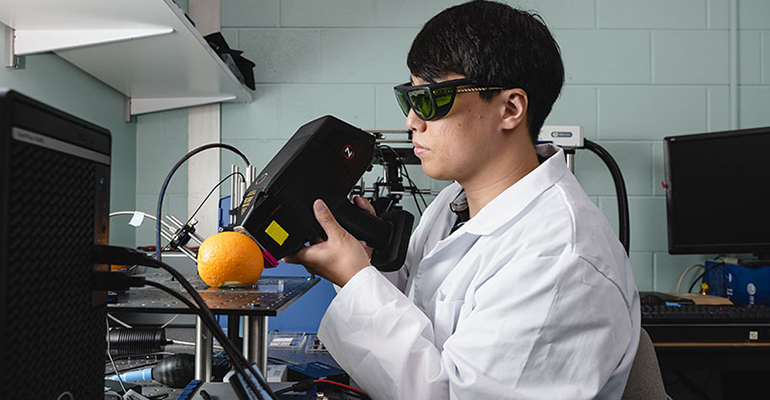News
Gourmet or imitation? Portable food fraud tool reveals products’ country-of-origin
9 Aug 2023US researchers have developed a portable food fraud detection method that can identify a product’s country-of-origin, differentiating a genuine Gruyère cheese made in Switzerland from a gruyere-style cheese made in the US.
Food fraud is a billion-dollar business and can take many forms, from ingredient substitution and adulteration to mislabelling. The consequences of food fraud can be serious, causing foodborne illnesses – or can simply leave consumers out of pocket.
“Think about the difference between a free-range ham from Portugal, aged in a cave for two years, and a ham you buy at WalMart,” said Bartek Rajwa, a research professor of computational life sciences at Purdue University. “They are both pig meat, the same ingredients, but they have a very different taste, smell and texture. To tell them apart, we need a system that can quantitatively analyse those characteristics. It’s a big challenge.”

Rajwa and his team of researchers have developed a patent-pending, two-part process to provide information about the atomic composition and chemical structure of a given food sample. Using two spectroscopy methods, they collect enough data point to accurately identify the ingredients, preparation and, potentially, the point of origin of the food or ingredient in question. The Purdue scientists have filed a patent for their method and are now looking for industry partners to commercialise the technology.
A new food application for laser spectroscopy
While spectroscopy methods, such as mass spectrometry, fluorescence spectroscopy, and liquid chromatography, are commonly used to identify food, no method is completely accurate.
The Purdue researchers therefore decided to use Laser Induced Breakdown Spectrosopy (LIBS), a method that is commonly used in material sciences and metallurgy but less used by the food industry. LIBS an atomic-emission spectroscopy technique that employs a focused laser beam to produce microplasma.
“The intensity of different wavelengths of light emitted by the plasma indicates the type and proportion of elements that make up the ingredients in the sample and even provides some valuable information on its texture,” said the researchers in a statement.
In this way, it creates a unique digital spectrum, which, combined with machine-learning, is processed into a fingerprint that can be used to verify the identity of the food tested.
Nevertheless, for more complex foods – such as cheese – the portable LIBS tool is not accurate enough and a second tool – Raman spectroscopy – is required. Raman spectroscopy can identify specific organic molecules in food, such as those associated with the presence of pesticides, fungicides, or antibiotics.
“In a sense, they form this complementary pair; what one cannot detect, the other can,” Rajwa said. “LIBS gives you the amount of each atom, and Raman tells you how they are organised.”
A fingerprint for food’s country of origin
The scientists have already published results in an open-access study in which they tested European-Alpine-style cheeses, coffee, spices such as nutmeg, pepper, and turmeric, balsamic vinegar, and vanilla extracts.
The method was 99% accurate in distinguishing imitation vanilla flavouring from real vanilla extract and about 90% accurate in identifying European cheese branded as “Gruyère” versus a Gruyère-style cheese produced in Wisconsin in the US.
 Pictured: Swiss Gruyére | © AdobeStock/barmalini
Pictured: Swiss Gruyére | © AdobeStock/barmalini
The research was funded by the US Department of Agriculture, Agricultural Research Service and was supported by SciAps, which supplied the LIBS instruments.
The University’s Purdue Research Foundation Office of Technology Commercialization has applied for a patent on the intellectual property, and is looking for potential industry partners to spin off the technology.
‘Food fraud can cause serious harm’
Rajwa, an expert in biological analysis techniques who was developing ways to identify bacterial contamination of foods, said he discovered the extent of global food fraud when attending food science conferences.
“[...] listening to leaders in the field, [...] I realised the scale of the problem. We’re talking about an enormous criminal enterprise that is almost unnoticed. Most of the time the only harm is that you’re paying a premium and getting a product of inferior quality, but there are instances in which it can cause serious harm.”
A huge number of food categories are subject to food fraud. According to the Foodchain ID Food Fraud Database, the common foods affected by fraud include coffee, cheese, olive oil, herbs and spices, seafood, meat, poultry, alcoholic beverages, honey, fruit and vegetable juices, and cereals.